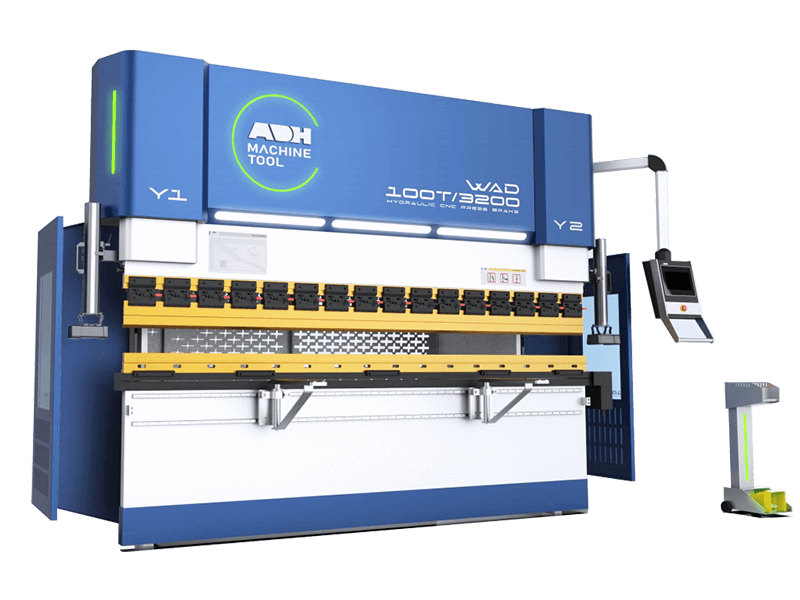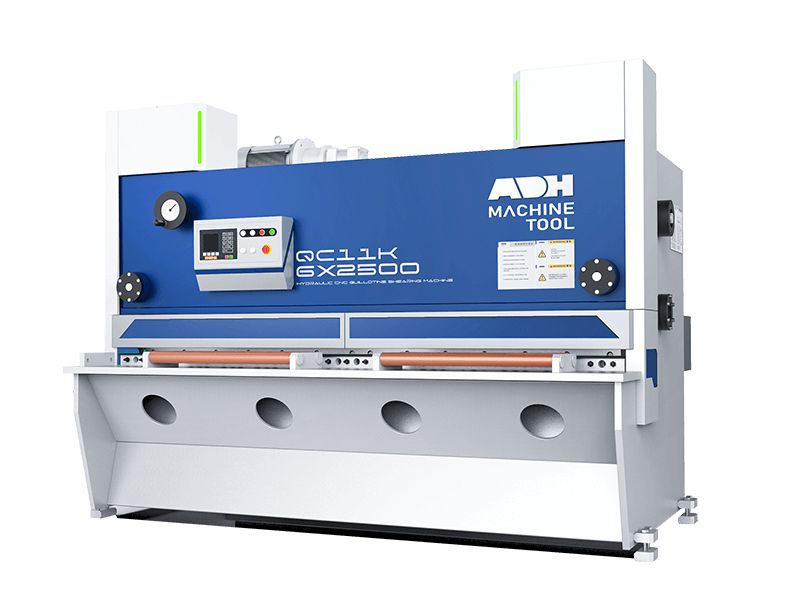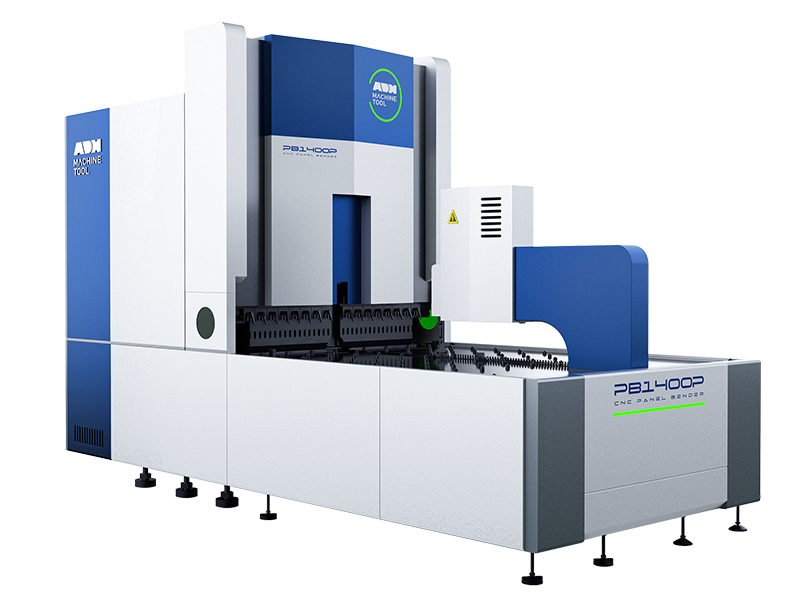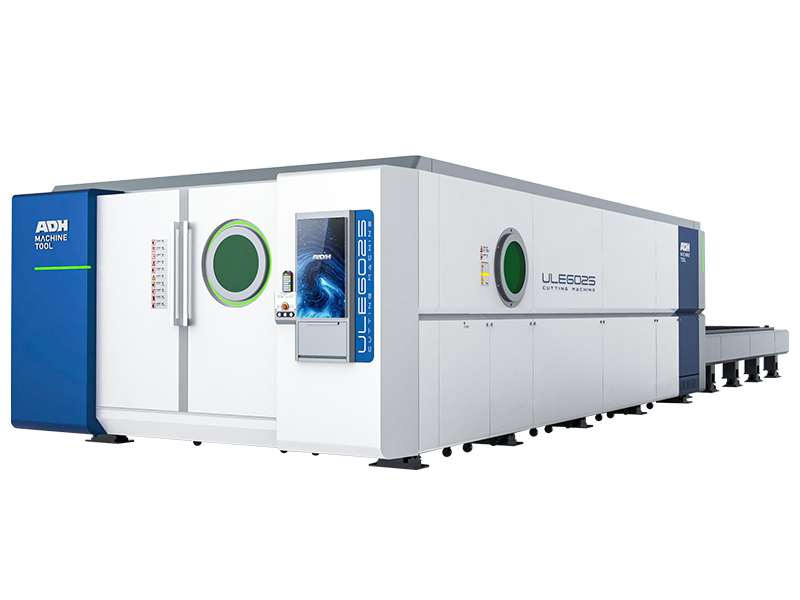I. Introducción
A prensa plegable es una herramienta de producción industrial común que se utiliza para curvar diversos materiales, como acero, aluminio y placas de cobre.
El conocimiento y la técnica de la prensa plegadora son sus fundamentos, que son primordiales para ayudarle a utilizarla en la fabricación.
Mi pasaje le mostrará esta información, incluido el factor K, el margen de curvatura y la deducción por curvatura.
El factor K, también conocido como factor de radio de curvatura, tiene en cuenta la tendencia del material a estirarse en la superficie exterior y comprimirse en la superficie interior durante la flexión.
El cálculo correcto del factor K es importante para determinar la posición del eje neutro y minimizar posibles defectos como grietas o arrugas.
El margen de curvatura se refiere al material adicional necesario para acomodar el radio de curvatura, evitando un estiramiento o compresión excesivos del material.
El cálculo preciso del margen de plegado es vital para garantizar que las dimensiones finales de la pieza se ajustan a las especificaciones del diseño.
La deducción por flexión, por otra parte, compensa el efecto de resorte del material, por el que la pieza doblada tiende a enderezarse parcialmente una vez eliminada la fuerza de flexión.
Tener en cuenta la deducción de la curva es esencial para lograr el ángulo de curvatura deseado y mantener la precisión dimensional.
Si comprende y aplica correctamente estos factores esenciales, podrá optimizar sus procesos de curvado, minimizar el desperdicio de material y producir de forma constante componentes curvados de alta calidad que cumplan los requisitos más estrictos.
II. ¿Qué es el factor K?
En primer lugar, debemos entender el eje neutro. Cuando se dobla una chapa, la superficie inferior se comprime y la superior se estira.
El eje neutro está situado en el interior del metal, donde no se comprimirá ni se expandirá, lo que le permite mantener una longitud constante.
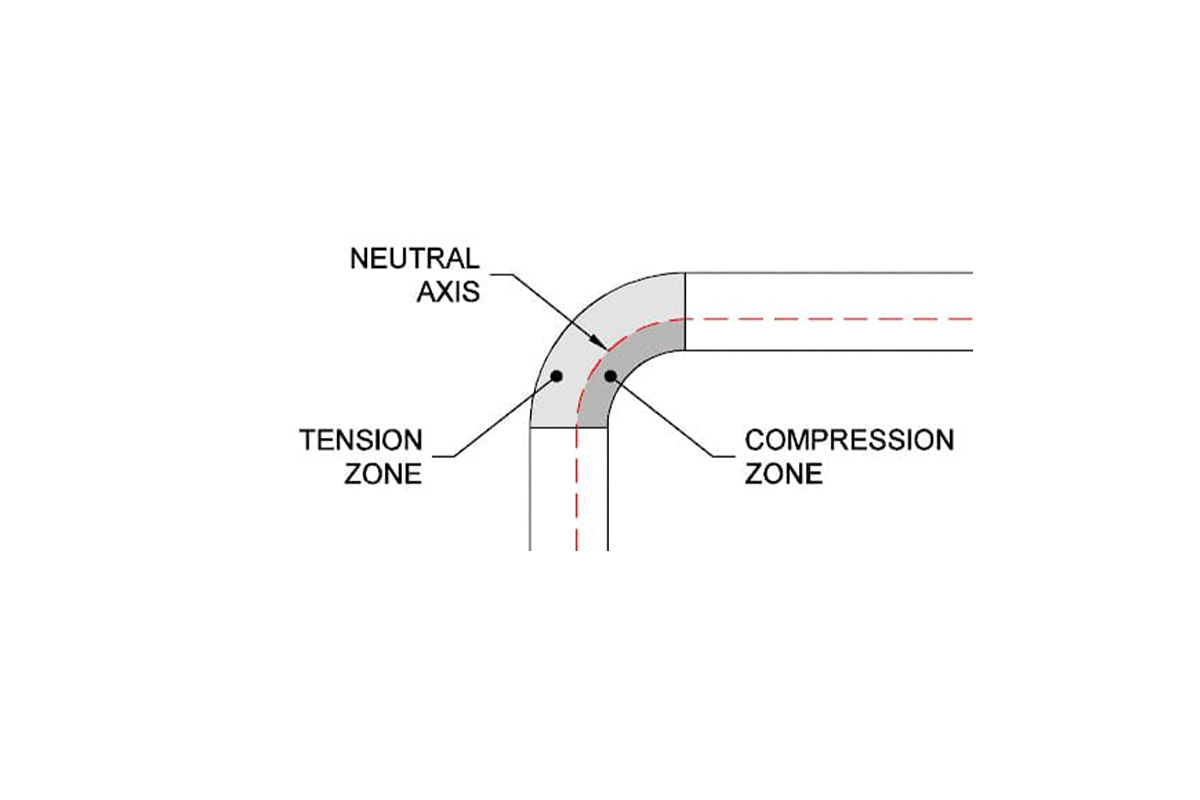
En la chapa plana, el eje neutro está situado uniformemente en la mitad del espesor de la chapa, pero se desplazará durante el plegado.
El cambio de posición del eje neutro viene determinado por diversos factores, como las propiedades del material, el grosor, el ángulo de flexión, el radio interno y el método de flexión de la placa.
Matemáticamente, el factor K representa la relación entre la posición del eje neutro (t) y el espesor de la placa (T).

Donde t es la distancia de la superficie interior al eje neutro y T es el espesor del metal (Figura 1).
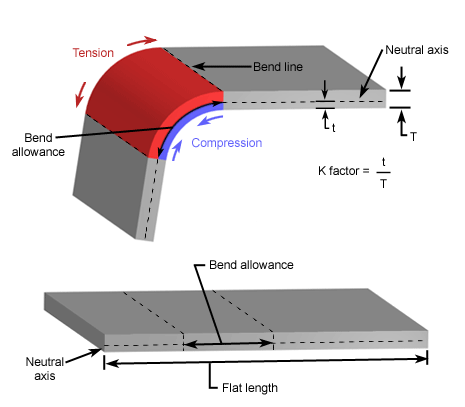
El factor K viene determinado por las propiedades físicas del material, el método de flexión, el ángulo de flexión y otros factores.
Propiedades del material: suele oscilar entre 0,30 y 0,50. En general, el factor K de los materiales de cobre blando o cobre suave es de 0,35, el factor K de materiales como el cobre semiduro o el latón, el acero dulce y el aluminio es de 0,41, y el factor K de materiales como el bronce, el cobre duro, el acero laminado en frío y el acero para muelles es de 0,45.
Radio de curvatura: cuanto menor sea el radio de curvatura, mayor será el factor K.
Grosor del material: cuanto mayor sea el espesor del material, mayor será el factor K.
Límite elástico del materialCuanto mayor sea el límite elástico, menor será el factor K.
Módulo elástico (también conocido como módulo de Young): cuanto mayor sea el espesor del material, mayor será el factor K.
En la fabricación de chapa metálica de precisión, el factor K es un factor crucial. El factor K se utiliza para calcular el patrón plano de plegado, que está directamente relacionado con la longitud de la chapa estirada durante el plegado.
Es el valor fundamental para determinar la franquicia y la deducción por flexión.
Dado que la relación entre la distancia al eje neutro y el espesor de la chapa determina la posición del eje neutro en la chapa metálica, conocer el factor K ayuda a determinar la posición del eje neutro tras la flexión.
También puede determinar el factor K utilizando la tabla siguiente:

También puede utilizar la función en línea y gratis Calculadora del Factor K para un plegado perfecto de la chapa
III. ¿Qué es el subsidio de curvatura?
La tolerancia de flexión (BA) es la longitud del arco de flexión medida a lo largo del eje neutro de la placa metálica, ya que la longitud del eje neutro no cambia después de la flexión.
Una vez calculada la sobremedida de plegado, debe sumarse a la longitud plana para determinar la longitud de chapa necesaria para formar la pieza deseada.
Como se muestra en la siguiente figura:
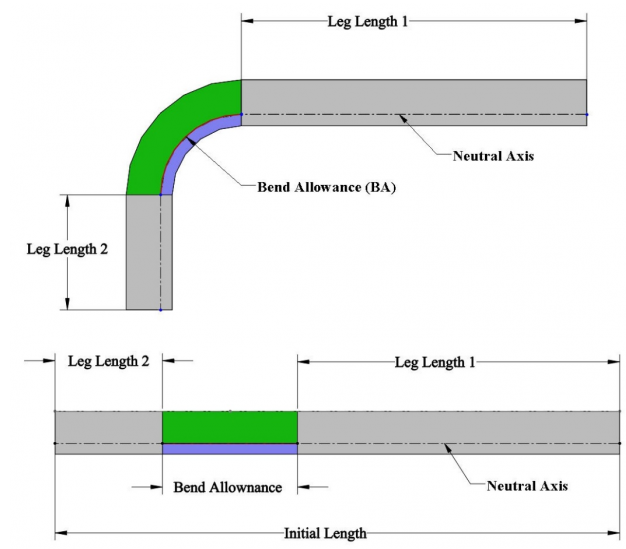
Para calcular la longitud plana se utiliza la siguiente fórmula:
Longitud de la chapa = Longitud de la pata 1 +BA + Longitud de la pata 2
Fórmula de cálculo del subsidio de curvatura:

Dónde:
A - Ángulo de curvatura
R - Radio interior
Factor K - K
T - Espesor del material
IV. ¿Qué es la deducción por cesión?
Tras el doblado, la longitud de la pestaña (es decir, la longitud total) es mayor que la longitud de la chapa plana.
La deducción de curvatura es la longitud de material que debemos eliminar de la longitud total de la placa para obtener el patrón plano correcto.
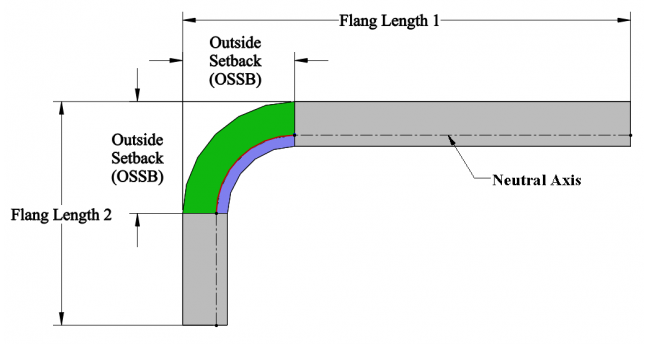
De acuerdo con la figura anterior, la deducción de curvatura es la diferencia entre la tolerancia de curvatura y el doble del repliegue exterior.
Fórmula de cálculo de la deducción de la curva:

Dónde:
OSSB - El retranqueo exterior (la longitud de la pieza que se extiende más allá del ángulo de curvatura).
R - Radio de curvatura
K - Factor K (determinado por las propiedades del material y el grosor)
T - Espesor del material
A - Ángulo de curvatura deseado en grados
Supongamos que queremos doblar una chapa de acero inoxidable de 2 mm de espesor en un ángulo de 90° con un radio de curvatura interior de 3 mm. Se sabe que el factor K de este material es de 0,44. Calculemos la Deducción de Curvatura paso a paso:
1. Calcule el margen de curvatura (BA):
BA = π * (R + K * T) * (A / 180)
Donde R es el radio interior de curvatura, K es el factor K, T es el espesor de la chapa y A es el ángulo de curvatura.
Introduciendo los valores:
BA = π * (3 + 0,44 * 2) * (90 / 180) = 4,39 mm
2. Calcule el retranqueo exterior (OSSB):
OSSB = R + T = 3 + 2 = 5mm
3. Calcule la deducción por curvatura (BD):
BD = 2 * OSSB - BA
Introduciendo los valores:
BD = 2 * 5 - 4,39 = 5,61mm
Por lo tanto, para conseguir una curvatura de 90° con un radio de curvatura interior de 3 mm en esta chapa de acero inoxidable de 2 mm de grosor, debemos establecer la Deducción de curvatura en 5,61 mm durante el proceso de curvatura.
Esto significa que tenemos que sobredoblar la chapa 5,61 mm para compensar el springback tras el doblado y, en última instancia, lograr el ángulo de doblado de 90° deseado.
El cálculo de la deducción por plegado puede ayudar a determinar las dimensiones de la pieza antes del plegado, lo que permite una mejor planificación de la producción y una reducción del desperdicio de material.
V. Conclusión
Mediante una exploración en profundidad del factor K, la tolerancia de flexión y la deducción de flexión, podemos comprender mejor el papel que desempeñan estos parámetros clave en el proceso de flexión.
El factor K determina el grado de estiramiento del material durante el curvado, la sobremedida de curvado define las dimensiones reales de la pieza después del curvado y la deducción de curvado ayuda a calcular las dimensiones de la pieza antes del curvado.
El cálculo exacto de estos parámetros es crucial para lograr un plegado preciso y reducir el desperdicio de material.
Sin embargo, el factor K, la tolerancia de flexión y la deducción de flexión deben determinarse mediante ensayos repetidos en la producción real, y los cálculos teóricos sólo pueden utilizarse como referencia inicial.
Si está buscando un fabricante profesional de prensas plegadoras, le recomiendo que tenga en cuenta a ADH Machine Tool.
Como líder del sector con más de 40 años de experiencia, ADH ofrece soluciones integrales de plegado a sus clientes gracias al excepcional rendimiento de sus productos y a un servicio de atención al cliente de alta calidad.
Puedes navegar por la página de productos de mi empresa para conocer las últimas actualizaciones de productos y especificaciones técnicas, y seguro que encontrará una plegadora que se ajuste a sus necesidades.

